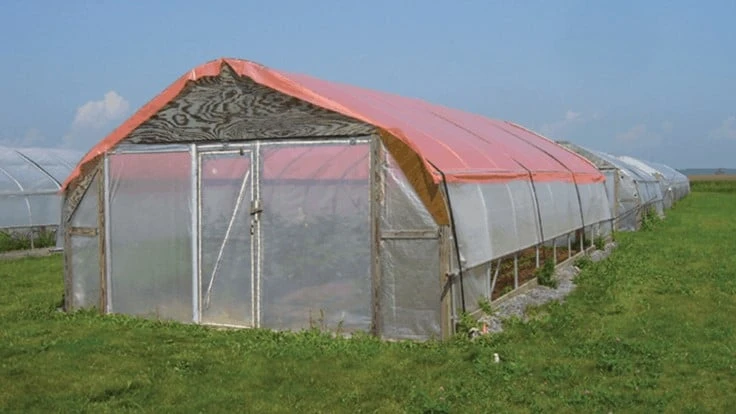

Today, more than two-thirds of new greenhouse construction is covered with film plastic. Besides the obvious advantages of low-cost, low taxes, ease of covering, four year life and additives such as anti-drip and light diffusion, there are other properties that should be considered when purchasing the material.
Manufactures have worked hard to provide a material that will give good service, high light transmission and properties that improve plant production. Most greenhouse polyethylene film is manufactured as a coextrusion of three or more layers with different polymers and additives. Each of these layers contributes to the quality of the film by adding tear and puncture resistance, high light transmission, IR retention, UV blocking, dust control and color pigments.
The following reviews some of these often overlooked properties that could influence your purchase decision.
Thermicity
A plastic film is considered an infrared film (IR) if less than 25% of the heat generated within the greenhouse is allowed to escape. The lower the percentage, the lower the winter heating bill. Regular greenhouse grade polyethylene film allows 30% to 60% of the IR heat to escape.
Plastic manufacturers have found that mineral based additives, such as ethyl vinyl acetate (EVA), calcined kaolin clay or synthetic aluminum silicate can reduce the radiation loss. This material is usually added as one of the inner layers in the copolymer.
These additives may reduce light transmittance slightly but they also diffuse the light spreading it evenly inside the greenhouse reducing shadows and allowing more light to reach lower into the canopy. It also helps to average out leaf temperatures at the top of the plant canopy reducing the amount of shading needed.
Flammability
Often building officials question a grower applying for a building permit as to the flammability of the film plastic. Section 3102.3 of the International Building Code states that “Plastic less than 20 mil thickness or located less than 30 feet above the floor as used in greenhouses where occupancy by the general public is not authorized is not required to meet the fire propagation performance criteria of NFPA 701 (National Fire Protection Association)”.
Low density polyethylene plastic is an oil-based product with a high heat value of about 20,000 Btu/pound. It will burn if in contact with an external flame but does not maintain a flame by itself for very long. The additives used in copolymers could affect this some so obtaining the test results from the manufacturer may be necessary. Also copolymer film may not get building official approval for retail greenhouses.

Photoselective films
These absorb or reflect specific wavelengths of light. They can enhance plant growth, suppress insects and diseases and affect flower development. Red films such as Dupont IR and Smartlite Red film reduce PAR light and create a shading effect. They have also been shown to improve rose yield and quality.
Disease Control
Plastic film manufacturers have developed disease control films that absorb UV radiation in the 340 to 390 nm wavelengths. These have been found to reduce the population of insects such as whiteflies, thrips miners and aphids. The material can also control the spread of certain diseases such as botrytis.
As bees need UV to navigate, if you are using bees to pollinate plants in the greenhouse, purchasing a film that allows some of the UV part of the light energy spectrum to pass through may be important.
Off-gassing from film
Recent research by Dr Sarah-Jeanne Royer at the University of Hawaii in Manoa has found that LDPE film produces methane and ethylene gas when exposed to sunlight. In large poly covered ranges the amount of gas produced may be significant. As these gases can affect plant growth, additional research is needed to determine the level that may have an effect.

Explore the May 2021 Issue
Check out more from this issue and find your next story to read.
Latest from Greenhouse Management
- Anthura acquires Bromelia assets from Corn. Bak in Netherlands
- Top 10 stories for National Poinsettia Day
- Langendoen Mechanical hosts open house to showcase new greenhouse build
- Conor Foy joins EHR's national sales team
- Pantone announces its 2026 Color of the Year
- Syngenta granted federal registration for Trefinti nematicide/fungicide in ornamental market
- A legacy of influence
- HILA 2025 video highlights: John Gaydos of Proven Winners





